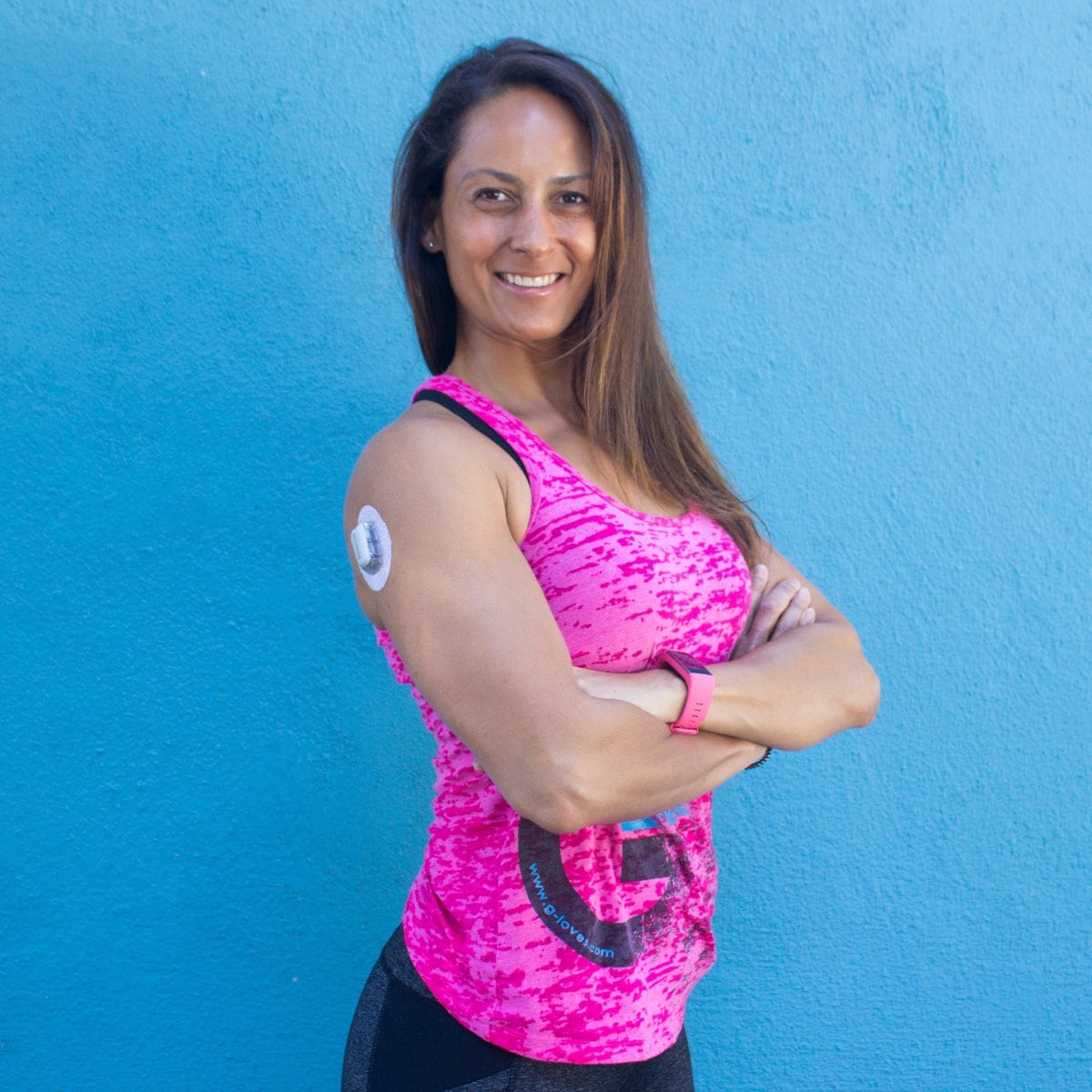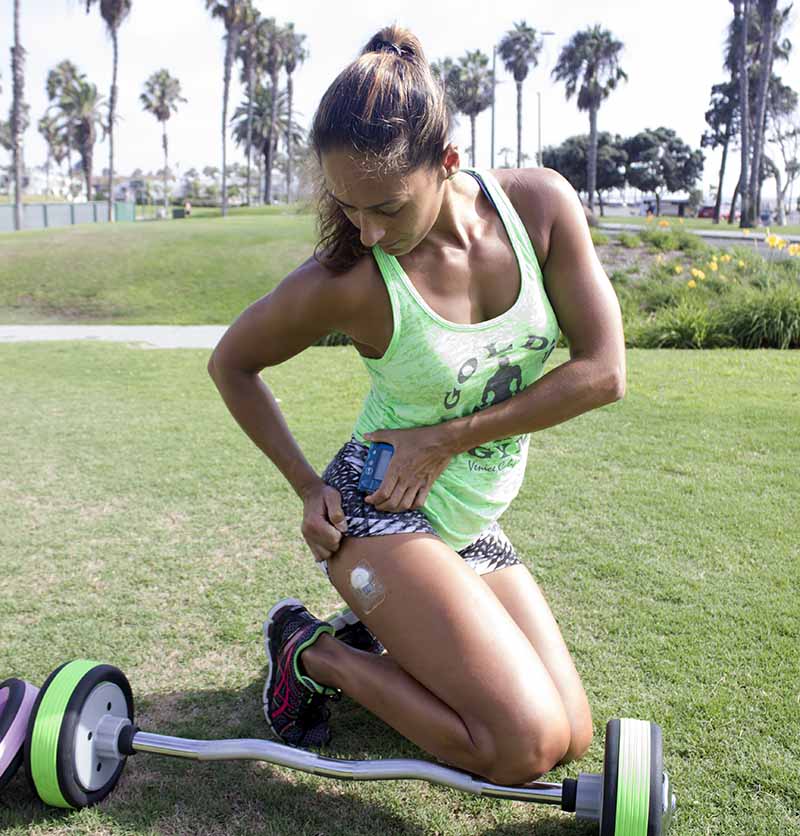You’ve probably seen me wearing a small device on my upper arm in a lot of the pictures on this website. That’s my continuous glucose monitor (CGM), a tool that’s instrumental in my daily diabetes management.
It’s a brilliant piece of equipment, and I absolutely love it (most of the time).

Key facts
- CGMs provide real-time and historical glucose data, improving awareness of how foods and activities affect glucose levels.
- These devices can help reduce episodes of hypoglycemia, improve A1c levels, and increase confidence and security in diabetes management.
- CGM use significantly reduces the need for traditional finger-stick monitoring, providing greater freedom in daily activities. This can provide peace of mind during exercise and other activities.
- Issues with CGM sensors can sometimes lead to inaccurate readings, potentially affecting diabetes management decisions, and the sensors can occasionally cause inconvenience or discomfort. Additionally, overreliance on the device can reduce personal judgment.
- Despite the potential drawbacks, CGMs are highly recommended for people with diabetes who take insulin, as they offer valuable insights into glucose trends and overall diabetes management.
- Which CGM system to use depends on a variety of factors, including compatibility with insulin pumps, smartphone integration and data accessibility, and lifestyle needs.
What is CGM?
A CGM device makes it possible for me to see my glucose readings in (almost) real-time and to track historical glucose data.
Most CGMs include three main components:
- A small sensor that is inserted just under the skin (where it reads glucose levels in interstitial fluid, or the fluid between body cells)
- An attached transmitter (this is the part you see on my arm), sends the readings to a receiving device
- A receiver or smartphone that displays the readings and glucose trend data
There are currently several CGM systems available for personal use in the United States:
- Abbott FreeStyle Libre 2
- Abbott FreeStyle Libre 3
- Ascensia Diabetes Care Eversense E3 (a fully implantable option)
- Dexcom G6
- Dexcom G7
- Medtronic Guardian Connect
My experience with CGM
I got my first Medtronic CGM in December 2012 and wore it every day for 18 months before taking a break. I then ordered my first Dexcom system in August 2016, and that has been my go-to since.
There are pros and cons to all CGM systems. Since I’ve only worn Medtronic and Dexcom devices to date, I’ll give you my opinions based on those so you can decide if a CGM might help you manage your diabetes better.
The advantages of CGM
Data
If you do finger-stick blood sugar checks and know your body well, you probably think you have a pretty good idea of what your sugars are up to between measurements. Chances are good, though, that you may be wrong.
I got a big surprise when I started seeing how much my blood sugar actually varied throughout the day, not to mention during the night when I usually don’t check.
CGM is a vital tool for providing this type of ongoing information over a 24-hour period that can show trends and patterns, as opposed to the snapshots at certain times during the day that are provided by traditional monitoring.
All of a sudden, I could see how certain foods and activities affected my glucose levels over the next several hours. That information is golden!
Plus, being able to spot low sugars before they hit (thanks to the alerts I set for when my sugar levels start dropping or get to a certain point) has really cut down on how often I have low blood sugar episodes.
It also means I’m consuming fewer glucose tablets and less juice to deal with said lows because I’m catching them earlier when less intervention is required to get my blood sugar back to the target range.
Management
So, what should we do with all this new information? In my case, it has not only helped me limit episodes of hypoglycemia (low blood sugar), but I have also managed to reduce my A1c level (a measure of glucose control over the previous 2 to 3 months) to around 6.0 percent.
My blood sugar has always been pretty well-regulated but has never been this stable before.
What’s more, some current CGM devices can integrate with an insulin pump, allowing you to monitor both glucose and insulin levels at the same time.
And certain devices combine CGM and insulin pump technology with an algorithm that automatically adjusts insulin dosing to help glucose stay within target range (the optimal level as determined by a person’s healthcare provider), in an innovation known as hybrid-closed loop (HCL) technology.
Current HCL devices on the market include:
- Medtronic MiniMed 770G
- Medtronic MiniMed 780G
- t:slim X2 Insulin Pump with Control-IQ Technology + Dexcom G6/G7
- Insulet Omnipod 5
Of course, just slapping on a CGM won’t manage your diabetes. However, careful interpretation and use of the data can help immensely.
For instance, I’ve learned that if I sleep any later than 8 a.m. before taking my morning insulin, I’ll be battling high morning blood sugar levels until at least noon.
I’ve also learned what kind of activities will make my sugars drop fast (in my case, that would be walking), my true levels of insulin sensitivity throughout the day, and that I always need a minimum of a half unit of active insulin on board (IOB) before a workout.
Gaining this knowledge took time and did include a few missteps, but that’s life, and that’s learning. The information has made it possible for me to optimize my training and has made it easier for me to stay in my desired range of 90 to 144 mg/dL (5.0 to 8.0 mmol/L) when exercising.
Confidence and security
My CGM has enabled me to understand my diabetes better. It has given me more confidence in the way I manage my condition and has helped me achieve tangible results.
It’s also comforting to know how my sugar levels are trending. I will even venture out sometimes without bringing all my diabetes gear. I also stopped monitoring 10 to 12 times a day because I no longer need to — the information is always right there on the screen in front of me.
Using this device has enabled me to go for a walk or a hardcore gym session without fearing lows and to reach both my fitness and diabetes health goals more efficiently.

The disadvantages of CGM
Accuracy
Anybody who has ever worn a CGM knows the frustration of doing a traditional finger-stick check and seeing that the sensor reading is off.
The reason behind this is that the technology isn’t perfect yet (although it is constantly improving), and the sensor measures your glucose levels in the interstitial fluid and not the blood. (There is generally a lag of a few minutes between your interstitial glucose levels and blood glucose levels)
Aside from the obvious issues, it can also be outright dangerous if you rely solely on the sensor readings and completely ignore what your body is telling you. For example, if the CGM alarms are going off telling you that you are at 250 mg/dL (13.9 mmol/L), it can be hard not to react immediately.
I have also had to stop workouts because the sensor incorrectly told me that my blood glucose was low or about to get low — always an annoying scenario when you’re in the midst of a good gym session.
Although some CGM devices are now highly accurate and approved by the U.S. Food and Drug Administration (FDA) for making treatment decisions, it is always wise to confirm any unexpected readings or readings that don’t match what your body is feeling with a traditional finger-stick before taking action.
(And several of the devices on the market, including the Medtronic Guardian and the Ascensia Eversense E3, require roughly two finger-stick checks a day for calibration.)
That said, it’s worth noting that the technology has improved tremendously over the years. According to a 2023 study, CGMs were shown to be 96.5 percent accurate in a real-world hospital setting.
Overreliance
This is actually the main reason why I originally stopped wearing my CGM and why I still take breaks on occasion.
This may not apply to everyone, but I have a tendency to rely on the readings and recommendations a bit too heavily. For example, if the reading said that my glucose was dropping quickly, I would trust it fully over how I actually feel. I think that’s a big no-no when it comes to diabetes management. In this scenario, it would be prudent to confirm the CGM information with a finger-stick check.
I have gotten a lot better at using the CGM as a data point and not necessarily as the complete truth, which has made it a far better partner in management.
Inconvenience
Having the CGM sensor attached to my body all the time can be extremely annoying. It’s not very big, and people don’t really notice it, but it can leave somewhat unattractive suntan marks. I also tend to scar easily.
If I wear it on my stomach, it tends to get in the way when working out, so I usually wear it on my upper arm. I find that I get pretty good readings with that placement. (One issue, though, is that it can be a little hard to get a sweaty sports bra off without ripping at the sensor.)
Wearing it on my upper arm has led to some pretty cool interactions and conversations with curious people. I don’t mind — I see it as an opportunity to educate and advocate.
But if it bothers you, there are plenty of other areas to place the sensor where it’s not visible. Typical manufacturers’ recommendations for sensor placement include the upper arm, stomach, lower back, thigh, and buttocks, depending on the specific device you’re using.
There are adhesives that can help strengthen the CGM’s adherence to your body. Refer to the instructions that come with your CGM and speak with your diabetes care provider about approaches that can work for you.
On a related topic, many people wonder if CGMs hurt. In my experience, there is only a slight pinching sensation upon inserting the sensor, and this momentary discomfort is well worth the data the device provides.
Plus, for the devices currently on the market, the sensors only need to be changed every 7 to 15 days (with the exception of the implantable Eversense E3, which typically needs to be changed by a healthcare provider every 90 to 180 days).
Related: Here is a post outlining my best CGM tips in which I talk more about how to put on the sensor (with a video) and how to make it stay on.
Price
Depending on your health insurance coverage, CGM devices and their associated supplies can be expensive. Check with your insurance provider to determine what costs are associated with CGM for you.

Final thoughts
Would I recommend a CGM to anyone with diabetes using insulin? The answer is a resounding yes, at least until you understand your body and your diabetes better.
The CGM will give you knowledge about your diabetes that you have never had before, and if, after a while, you feel like you no longer need it, speak with your diabetes care provider about other options.
The key for me when using my CGM is to get better at listening to both the CGM and my body. It’s a fantastic device, but it’s not a substitute for my own thinking and experience.
It’s a great tool to have in my diabetes toolbox, but it can’t stand alone.





Sue
HI, You may not be aware that there is now the “FreeStyle” Libre, Flash Glucose Monitoring System.
It was very recently approved and I have had one for two weeks. I was the first one to order it from
my pharmacy. It is “a continuous glucose monitoring device indicated for the management of diabetes
in persons 18 and older. It is designed to replace blood glucose testing for diabetes treatment decisions.”
You mentioned that there were only two systems available but now there are three that I am aware of.
Christel Oerum
Hi Sue – that’s a great comment. While the Libre system is a really cool addition to the diabetes management toolbox it’s not a CGM but rather considered a fingerstick replacement. As you know you have to “swipe” the receiver to get a reading and it doesn’t give you alarms and alerts, but as an upside, you don’t have to calibrate it.
Mary
Unfortunately when sensor was carefully removed from upper arm I was left with two abrasions and puncture marks. Maybe that’s why my Dr said it could only be left on ten days. Now I have a wound to heal I can’t imagine an arm with multiple wounds and am very disappointed.
Christel Oerum
Yikes, was that due to a Libre sensor? Almost sound like an allergic reaction?
Brendan O’Kane
I live in the UK and use the Abbott Libre Freestyle. For me CGM is a game changer and combined with an insulin pump provides greater flexibility especially when undertakingg extended periods of exercise. I am 57 years old living with type 1 diabetes. I have been lucky enough to take part in endurance cycling events riding across France and the knowledge CGM brings is phenomenal. However the effects of aerobic and anaerobic are counterintuitive, seeing blood glucose rise after a steep hill is spooky.
Christel Oerum
I glad the combination is a winner for you! And I really agree that sometimes watching the curve climb can be a nailbiter
Pamela Coffey-Urban
I have the Dexcom G5 and am able to turn my alerts on and off, which is very helpful at night. I always keep the low alert on, but will turn off the high at night. It has had a huge impact on my life as my A1c is now where it needs to be and I’m not eating unnecessary snacks in fear of lows. My husband and I both sleep better than we have in years because we don’t worry about the lows at night. It is very pricey because I have a high deductible and I am hoping the price will come down as it becomes more mainstream.
Christel Oerum
I’m so glad to hear that CGM has been such a life changer for you. And I’d also love for the price to come down some 🙂
Shauna
The only thing that you haven’t mentioned is how expensive these cgms are – in Australia nearly $800 for the system and then, supposedly over $100 a month for the ongoings – sooo important for me as a single parent to have one but with no government assistance here, it’s completely unavailable to me, I was lent one for two weeks and the amount of lows I prevented were truly life changing, it’s an amazing piece of equipment for enabling a diabetic to work their levels out.
Christel Oerum
Yes, it can be very expensive if you don’t have coverage. I don’t really dig into costs since they differ greatly across the world, and in the US it will depend on your type of insurance. But it’s such a shame that it’s so expensive since as you mention it can really help prevent lows
Paula
Interesting read. I am T2 and don’t take insulin at this point but think it’s cool to have all the real time info. Are these expensive? Could a T 2 use for education? Sometimes I need more info than I have to evaluate my choices.
Thanks for sharing. You are a great writer engaged in helping others. All the best….
Christel Oerum
Hi Paula – thank you!
If you are in the US I suggest you call the company you would like a CGM from directly and ask what it would cost you. They are not cheap, but the level of co-payment really depends on how good coverage you have. Another option would be a sensor you wear for 7-14 days and your doctor does the analysis with you (I believe it’s only Medtronic, Dexcom and Abbott that offers that). That’s not real time though, and since you’re on insulin, you might benefit more from CGM. Your endo would be a good person to discuss that option with.
Leana
Thanks so much for posting this! I am currently on the Dexacom and it’s nice to know that I am not the only one who finds you can’t turn off the alarms. Even if I correct sometimes it takes a couple hrs for me to go down and if I am sleeping or at work, I don’t want to hear the alarms.
And yes! The CGM is not always right on target! Which is annoying. But like you said it does help me not to have to keep checking my sugars all the time to see where I am at or which foods I react to.
But thanks for posting! I wouldn’t give up my Dexacom and currently have to wait for the pump. Not sure if the pump will work for me but I think my nurse will let me trial run on it. So your on Dexacom and the pen? Not the pump right.
Christel Oerum
Hi Leana,
Yes, I use pens and CGM. I think you more often find the pump+CGM combination but pens+CGM really works for me.
I hope you’ll be happy with your pump, I know so many who loves theirs
Laura
I would love to hear your reasons for using the MDI instead of the pump?
Christel Oerum
Hi Laura – whether a pump is the right choice is going to vary by the individual and for me, it’s a personal choice. I fully understand the benefits of pumps and know many who love theirs. I personally prefer a long-acting basal as background insulin rather than a rapid-acting insulin. And I’m willing to dose and test as much as needed, meaning that it’s doubtful that I’d get tighter control with a pump (current A1C is 5.9% with a high time in range). I think you need to know and understand the options available and then find what works for you.
Emily
Hi Christel-this was super helpful! I’ve had diabetes for almost 25 years and have never used a CGM (the technology wasn’t around when I first got a pump and just never got around to getting set up with one). The biggest hesitation for me is having the two sites going on at all times (I use the omnipod). You were mentioning your upper arm is best for you (thats where I put my omnipod) so wondering if you or anyone else here has experience balancing having the two injection sites? I already struggle to rotate my pod around and still feel like I can sleep and exercise comfortably with it on. Let me know! Any insight would be super helpful 🙂
Christel Oerum
I completely understand the hesitation related to multiple sites. I have friends who use Omnipod+CGM, so I’ve seen some with one on each arm, while other use other sites (lower back, abdominal, legs, etc.). I think you just have to be careful not to have the two sites too close to each other.
Although my upper arm is my preferred, I also use lower back, right above the belt. I do require a bit of flexibility to get it back there but is doable.
Mike R
I’m currently using Dexcom with Omnipod and rotate the sites between right and left belly and arms, where I have some fat. Omnipod site changes every three days and the Dexcom site changes every seven which makes the rotation a bit complicated but not a bother. Rotation is important to minimize scar tissue and keep insulin absorption high.
Mike R
Looking forward to the new Omnipod/Dexcom artificial pancreas next year.
Mark Gutman
I’ll add my voice to loving my CGM and the data it provides. Some worry about data overload, but I love being bg able to react more quickly to changes in my BG and you learn whay works better and what does not.
One note: Both the Animas Vibe and the Tandom pump integrate at least loosely with the Dexcom G4 CGM. The pumps don’t make changes – yet – but CGM data, but the information is available on the pump itself without the separate receiver. New versions of those pumps will further integrate, hopefully soon.
Christel Oerum
Hi Mark, thanks for the note. You are completely right on the integration, that was poorly worded and I’ll update it.
Glad to hear you also enjoy the data flow
Josh
Just found the blog and have enjoyed the first few articles that I’ve read. I’d be interested to get your thoughts on the CGM the second time around. I wore one for a few months a couple years ago but got frustrated and stopped when it was waking me up most nights. I know it would help my a1c but I think since I’m an avid runner I have nighttime fluctuations that cause it to go nuts.
Christel Oerum
Hi Josh,
I know what you mean, the alarms can be extremely annoying if you don’t need them. I fix that in two ways.
1. I’ve adjusted my Glucose Range setting from 12am-6am to be pretty broad (50-180)
2. If I know I’ll have fluctuations, but don’t expect to go severely high or low I’ll put it on silence
Of course, #2 only makes sense if you don’t need the readings real time. Like last week my sugars were weird (unexplainable morning highs), so I slapped on a sensor and it helped me identify a trend for when (around 1 am) my sugars started to creep up. So that information helped me fix it, but I didn’t need the info real time.
This week I have incorporated evening cardio which has made my sugars tank (took a total of 3.5 units bolus yesterday), so these nights I don’t have it on silence. I want it to wake me up if I’m about to crash.
Hope this answers your question – Christel
GiGi Eats
GREAT POST!!! THANK YOU for motivating those with diabetes to make fitness a priority! Being diagnosed is NOT a death sentence.